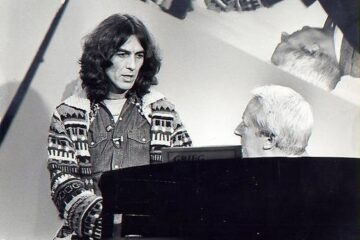As much as the music, it’s the individual Beatles’ behavior that is the star of ‘Let It Be.’
Whenever The Beatles put out anything, people go nuts. When Michael Lindsay-Hogg’s Let It Be film came out in 1970, people wanted to pelt it with nuts.
The odds were stacked against it from the beginning. For one, The Beatles had already disbanded when it launched, and none of them attended the premiere. Also, as a marker of things coming to an end – youth, the ‘60s, the counterculture – it was a bit of a downer.
It was a bit like Zamboanga moviegoers rioting at the end of Asedillo, because, duh, FPJ movies don’t end with him dead. By the same merit, you just don’t show The Beatles not getting along. It just isn’t how things are done.
Though the accompanying namesake album was, chronologically speaking, the band’s last release, it was really just their penultimate effort; the distinction of being their actual swan song belonged to Abbey Road: the superior record, the more vibrant musical statement, the more joyful ta-ta.
As Ben&Ben embarks on a new chapter in their musical journey, what are their dreams and vision for the future?
‘In this day and age, it’s not easy to just go to a concert…. But you chose to spend your time and your well-earned money on me, and I really appreciate that,’ the Irish singer-songwriter tells the crowd at the MOA Arena
But maybe we’re all wrong, and hindsight will finally give Lindsay-Hogg’s film its due. The good news is you can forget all that hand-me-down wisdom about Let It Be and fashion your own, because Disney+ released the Peter Jackson-remastered version on May 8.
“It really didn’t get a fair shake the first time,” Lindsay-Hogg tells Jackson in the preface included in the reissue. “Finally, it’s going to get a chance to be embraced for the curious and fascinating character that it is.”
A perfunctory recap is in order: In 1969, John Lennon, Paul McCartney, George Harrison, and Ringo Starr wanted to go back to live performances. They quit doing concerts in 1966 – the “more popular than Jesus” era, a.k.a. the mauled-by-the-dictator’s-goons era – and have become a studio-only outfit that favored sitars, tape splices, and flanging Leslie amps. The Beatles weren’t supreme technicians, but they did cut their teeth in Hamburg bars and Liverpool dives, and they’ve apparently missed those days.
They wanted their return to the stage to be a red-letter event, and they asked Lindsay-Hogg to make a documentary of the preparations.
“I had this vision: it would start at 5 in the morning and end at midnight with 2,000 people in the amphitheater,” the director recalled his plans.
Unfortunately, but quite naturally, life happens: the cameras bothered them (except Macca), they argued over song arrangements, they complained about the sound at Twickenham (the same facility where they shot parts of “A Hard Day’s Night” and “Help!”), and – oh, not so little detail here – George quit.
Obviously, he was wooed back in, and that transition – where they move from Twickenham to the more familiar confines of EMI (now known as Abbey Road Studios) – was a Hail Mary for Lindsay-Hogg. It made for a shift in tenor, and hence a story, and stories are what documentarians should be after, not mere fly-on-the-wall reportage.
But who are we kidding, right? Viewers of Let It Be (our folks in 1970, us in 2024, and all the bootleggers in between) are most curious about what goes on in a Beatles session. Well, this was as open-door as they could get, circumstances be damned, and now we get to see and hear it more clearly (thank you, Peter Jackson and Giles Martin). This isn’t necessarily a blow-by-blow – it is, after all, an old movie – but a reframing of what has been, until now, a scorned artefact by an otherwise universally adored band.
Beyond being a writing-arranging-recording procedural, Let It Be provides a partial answer key to the mysteries of The Beatles’ workflow. It is also, regrettably, a sort of anti-handbook on how collaborations should work. It makes you wonder when decisiveness ends and tyranny begins, or whether or not spontaneity is overrated, or whether brainstorming – ugh, brainstorming – really is a viable means to arriving at something cohesive.
Paul McCartney is, of course, these sessions’ concurrent hero and villain: he thought of it, he fought for it, he bought it from the get-go. And along with John Lennon, he is boss, so there were no reds at the traffic lights. You often see him playing to the cameras, and it’s adorable how he always has an amusing anecdote or cheery spiel to spare when they’re rolling.
As for song arrangement, Let It Be shows band people that band work is politics: It doesn’t matter if you came in with a good-to-go draft – Harrison’s “I, Me, Mine,” Lennon’s “Across the Universe,” Macca’s “The Long and Winding Road” – your diligence doesn’t guarantee the work will be met with enthusiasm. What guarantees enthusiasm is enthusiasm: your ability to sell an idea no matter how formed (or unformed) it is.
There’s also the matter of who’s doing the pitching, and how that itself answers whether the contribution will be taken seriously or not. That’s why the sequence where Starr presents his germ of “Octopus’s Garden” to Harrison (and Harrison alone) remains sweet but also poignant. Despite the drummer’s affable neutrality – he’s the band’s Switzerland – he chooses the youngest bandmate to run it by. And because Ringo is Ringo, he’ll sit adoringly beside Paul noodling aimlessly on the piano, but he’ll also gleefully hear out George’s new “heavy waltz” (“I, Me, Mine”) like it was the most important thing in the world.
As much as the music, it’s the individual Beatles’ behavior that is the star of Let It Be: They’re snarky for laughs, they’re nice around Paul’s family (Ringo is adorable with young Heather), they seem, hmm, tolerant of Yoko Ono. And most amazingly, they’re on their best, musically and socially, around session keyboardist Billy Preston. He’s the houseguest they couldn’t be messy around with, because he’s in the same trade and they’re supposedly masters in said trade.
That mastery is often on full display in blues-based rockers like “Suzy Parker,” where their collective Hamburg-Cavern experience shines. Lennon is surprisingly versatile in these sequences, handling solos (“Get Back”), lap steel (“For You Blue”), and even bass (“The Long and Winding Road”) at varying points. He looks like he knows he’s not a technical MVP, but his focus and diligence more than make up for it.
There’s both hard and soft at the core of Let It Be. When it first came out, people basically zeroed in on two things: the rooftop set being “interrupted” by the police, and the tiff between Paul and George, where the latter sardonically promises, “Whatever it is that will please you, I’ll do it.” What deserves real focus, however, is the boys’ sheer exhilaration at nailing an arrangement. The call-and-response during “I’ve Got a Feeling,” when they figured it out finally, was a unicorn moment. At that moment – and a few others like it – it felt like everybody had a wet dream, everybody saw the sunshine. IYKYK.
At this juncture it feels necessary to mention Peter Jackson’s Get Back mini-series and the general wisdom that it’s a corrective to Let It Be – it provides context, shows a fuller picture of the creative process, and so on – but one can’t help but ask if all of that was even necessary. I mean, do we really need to hear all the rough takes of “Get Back”? Or, for that matter, all their attempts at “Don’t Let Me Down” on the roof?




